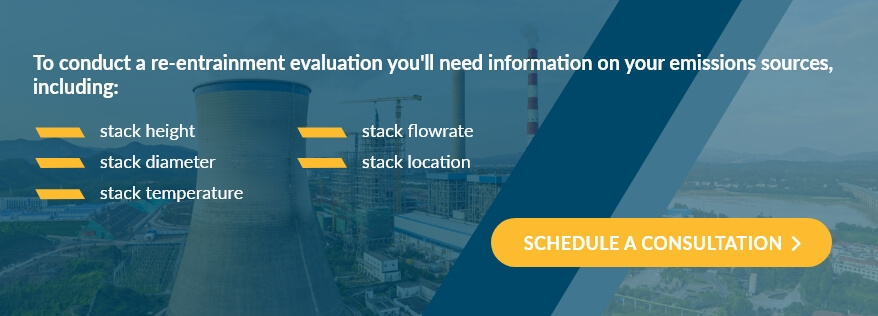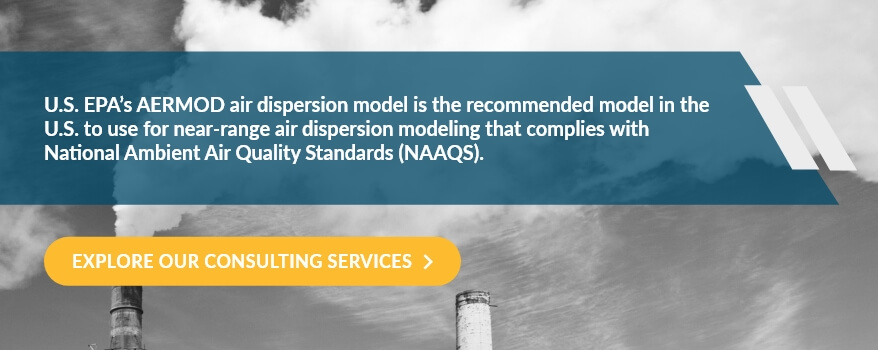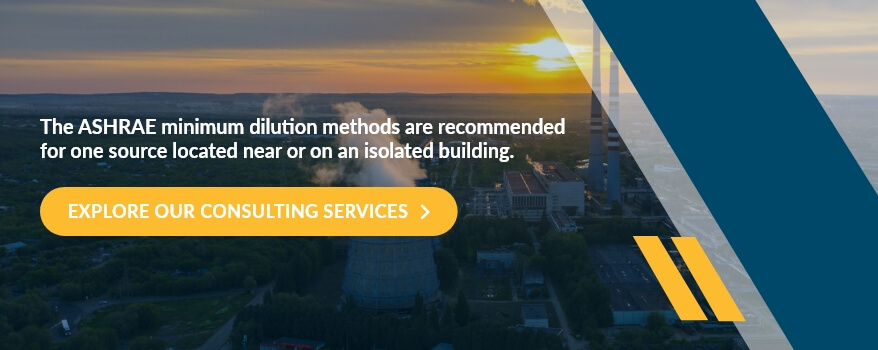Re-Entrainment. What is it and should you be evaluating it for your site or next project?
Posted: May 17th, 2017
Authors: Amanda E. Dan D.
|Who should consider a re-entrainment evaluation?|Information necessary to conduct a re-entrainment evaluation|AERMOD|ASHRAE Minimum Dilution Models|Hospital Example Re-Entrainment Evaluation|Ship Example Re-Entrainment Evaluation|Recommendations|
Have you ever seen a plume from a stack swirl around when it gets caught in the wake of a building? Have you seen buildings with air intakes downwind of short stubby stacks or tucked next to back-up diesel generators? These conditions are prime examples of situations where plume entrainment, or re-entrainment, can give rise to elevated contaminant concentration levels that can unnecessarily expose the general public or workers to elevated levels of air contaminants. Assessing the potential for re-entrainment should be of special concern to all project designers or facility managers for existing sites.
So what is re-entrainment? As Amanda Essner discussed in her recent blog post, Re-entrainment is an atmospheric event that occurs when contaminants that are exhausted in a plume from a stack are mixed back into the original volume of air. A scenario of particular concern is where fresh air intakes are located nears areas of plume re-entrainment. The re-entrainment is typically caused by a combination of short stacks, the presence of nearby buildings and structures, and meteorological conditions associated with poor atmospheric dispersion.
ALL4 has been evaluating how pollutants from emissions sources can be re-entrained because of plume interaction with structures and impact nearby locations where the general public or employees have regular access. By using air dispersion modeling to predict concentrations at locations susceptible to re-entrainment, ALL4 can assess if the designed configuration of a site or equipment could result in dispersion scenarios where re-entrainment has the potential to cause concentration levels that exceed published health guidelines or air quality standards. Furthermore, ALL4 can propose stack configurations changes to alleviate the issue for existing sites or suggest stack and building configuration changes to proposed sites in development. ALL4 has evaluated re-entrainment scenarios from many different types of emissions sources including hospitals, pulp and paper mills and even seafaring ships on the Great Lakes. In this article we’ll discuss who should consider a re-entrainment evaluation, the information necessary to conduct a re-entrainment evaluation, the models available for conducting re-entrainment evaluations, and provide some real-world re-entrainment evaluation examples.
Who should consider a re-entrainment evaluation?
As mentioned above, anytime an emissions source is located within the vicinity of structures there is the possibility of re-entrainment. Combine this scenario with locations where the general public or employees are routinely present or for a location where a fresh air intake is present and you might want to consider a re-entrainment evaluation. This evaluation is especially true for emissions sources that have low release heights and are located by nearby structures such as buildings, tanks, earthen berms etc. A common scenario that requires a re-entrainment evaluation is an emergency generator located adjacent to a building and near a building air intake. Other scenarios include facilities where low elevation stacks are located near tall buildings and where employees are routinely working near the stacks and buildings. This stack and building configuration is common at many industrial facilities. Lastly, even large mobile sources such as seafaring ships can be subject to re-entrainment scenarios where plumes from short stacks, which are required to pass under bridges, are influenced by the large structures on deck and can present re-entrainment concerns for the ship’s crew. I’ve just provided a couple of examples but I think you get the idea.
Information necessary to conduct a re-entrainment evaluation
The information necessary to conduct a re-entrainment evaluation is easy to assemble and should be readily available whether you are in the development stages of a project or already have the project built. Information on your emissions sources including stack height, stack diameter, stack temperature, stack flowrate, and stack location is necessary. In addition, detailed dimensional information on all nearby structures is required. Emissions rates can be calculated for pollutants of concern utilizing published emissions factors or based on vendor guarantees. Unprocessed meteorological data can be obtained for free from nearby weather stations from the National Climatic Data Center (NCDC) or a worst case matrix of artificial screening meteorological data can be developed for your site. Once the data is collected the next consideration is what type of approach should be used to assess for re-entrainment. Here are two primary approaches ALL4 recommends for conducting re-entrainment evaluations depending on the type of source(s) and surrounding structures. Each of these primary approaches is discussed below. A secondary approach involves conducting a wind tunnel study. However, the cost and time associated with a wind tunnel study is far greater than the two primary methods discussed in the following paragraphs.
AERMOD
U.S. EPA’s AERMOD air dispersion model is the recommended model in the U.S. to use for near-range (within 50 kilometers), air dispersion modeling for compliance with the National Ambient Air Quality Standards (NAAQS). Although the NAAQS evaluations apply to “ambient air” (i.e., the portion of the atmosphere, external to buildings, to which the general public has access), AERMOD has been used in on-site evaluations, for example, of air toxics. AERMOD can be used for re-entrainment evaluations since it is readily available and widely accepted as a preferred air dispersion model.
AERMOD is appropriate for this application for a number of reasons. First, AERMOD allows the user to input building dimensions and tiers to account for building downwash. This is critical because the re-entrainment evaluation looks at onsite impacts where exhaust air can be pulled back into a building (e.g., at fresh air intake units), typically located on the sides or roofs of buildings. Receptors can be set at flagpole heights; that is, they can be raised up (as opposed to always being at ground level) to be located at the height of the fresh air intakes. AERMOD also allows the user to predict concentrations for both single sources and the combination of multiple sources. In addition, meteorological data is readily available through the NCDC online and can be used in AERMOD after being processed.
ASHRAE Minimum Dilution Models
The American Society of Heating, Refrigeration, and Air Condition Engineers (ASHRAE) provides a geometric stack design method for estimating the minimum stack height required to avoid plume entrainment in the flow recirculation zones of structures. The ASHRAE method was designed to avoid plume entrainment into building air intake vents. The method modifies the Gaussian equation utilized by AERMOD, however; still utilizes many AERMOD equations such as plume spread (i.e., sigma-y and sigma-z) and plume rise. There are two ASHRAE minimum dilutions methods, one for vertical stacks (Dr) and one for wall vents and capped stacks (Ds). For both methods the same general information necessary to use the AERMOD air dispersion model would also be needed for the ASHRAE minimum dilution methods. The ASHRAE minimum dilution methods are recommend for one source located near or on an isolated building. If there is more than one source or multiple and complex nearby structures AERMOD may be a better option because it can handle the complexity of multiple sources and structures in a single analysis whereas the ASHRAE methods could require multiple analyses.
Hospital Example Re-Entrainment Evaluation
An engineering company designing a new hospital building requested a re-entrainment evaluation of the design. The project included a main hospital building and a separate central utility plan (CUP). The proposed main hospital building included two domestic hot water heaters and one steam boiler, all firing natural gas. The proposed CUP included two ultra-low sulfur diesel (ULSD)-fired emergency generators and three hot water boilers running on natural gas with propane back-up. Seven fresh air intakes were to be located on the main hospital building. The pollutants of concern were carbon monoxide (CO) and nitrogen oxides (NOX). The complexity associated with multiple buildings, multiple sources and several fresh air intakes dictated the decision to use AERMOD for this evaluation.
Equipment was modeled at full capacity operating simultaneously at worst-case conditions. Modeling concentrations of CO at the fresh air intakes and air handling units did not exceed health guidelines or the NAAQS. However, issues arose when evaluating NOX emissions from the emergency generators. Since the building and equipment were still in the design phase, the emergency generators were modeled in two different configurations: (1) with the stacks closest to the building and (2) with the stacks farther from the building (i.e., turning the equipment to face away from the building).
Various design iterations were evaluated in which the emergency generators operated alone or as a pair at full load, and then when the emergency generators operated at lower loads. The results of the evaluation showed NOX concentrations at the various air intakes were below the NAAQS and published health guidelines when modeling the emergency generators facing away from the building; therefore, a recommendation was made to the engineering company to turn the emergency generators around so that the stacks were farther away from the buildings. Since this layout of the emergency generators resulted in a favorable re-entrainment evaluation for NOX, the engineering company was able to use the recommendation to consider necessary changes to the design plan.
Ship Example Re-Entrainment Evaluation
An iron-ore ship that operates in the Great Lakes had recently installed a scrubber on the main engine exhaust which resulted in a moist and cool plume. The wet and cool plume buoyancy was lower than prior to the installation of the scrubber and as a result the ship company increased the stack heights on the main engine exhaust by 10 feet (ft). The ship company then conducted CO monitoring, which did not indicate elevated levels of CO onboard. To confirm further that the crew’s health was not being affected by the new stack configuration, a re-entrainment evaluation was conducted using U.S. EPA’s AERMOD air dispersion model. The intent was to evaluate ambient air concentration levels from the main engine exhaust under a full range of meteorological conditions that the ship could experience while traveling the Great Lakes. Additionally, the re-entrainment evaluation also included an evaluation of emissions from four ship service generators and two boilers.
Stack parameters and the ship structures were obtain from engineering drawings of the ship and stack testing was conducted on the main engine and boiler exhaust stacks to obtain site-specific temperature and flowrate information since no data was available after the installation of the scrubber. Ship pollutant emissions were calculated utilizing U.S. EPA emissions factors for input into the AERMOD dispersion model. Lastly, a “site-specific” matrix of worst case meteorological conditions was developed utilizing U.S. EPA’s MAKEMET processor. Using MAKEMET enabled the development of a worst case matrix of meteorological conditions that the ship could experience while traveling on all of the Great Lakes. AERMOD was utilized to calculate pollutant concentration levels at locations on the ship deck where crew had access to and at the ship’s heating, ventilation, and air conditions (HVAC) system intakes. The modeled concentration levels at these locations were compared to NAAQS and published worker health guidelines.
The conclusions of the re-entrainment evaluation determined that the potential for a small amount of main engine exhaust re-entrainment could occur during extreme meteorological conditions. However, during all meteorological conditions it was determined that pollutant concentration levels on-board the ship were well below the NAAQS and published work health guidelines. Therefore, additional stack configuration changes were not necessary.
Re-Entrainment Recommendations
If you’re responsible for the development of a new site that includes emissions sources and structures, the possibility of re-entrainment leading to elevated concentration levels of pollutants exists. Therefore, an important part of the design process should include a re-entrainment evaluation. Additionally, if you’re responsible for the health and safety at an existing site where the potential for re-entrainment exists, there could be stack configuration changes made that could be identified by a re-entrainment evaluation to mitigate any existing or potential issues. If you have any questions about how re-entrainment may be affecting your development site or existing site please contact me (610.422.1118, ddix@all4inc.com) or Amanda Essner (610.422.1129, aessner@all4inc.com), and we can provide some guidance on the best approach for avoiding and remediating potential issues.
Contact Us







